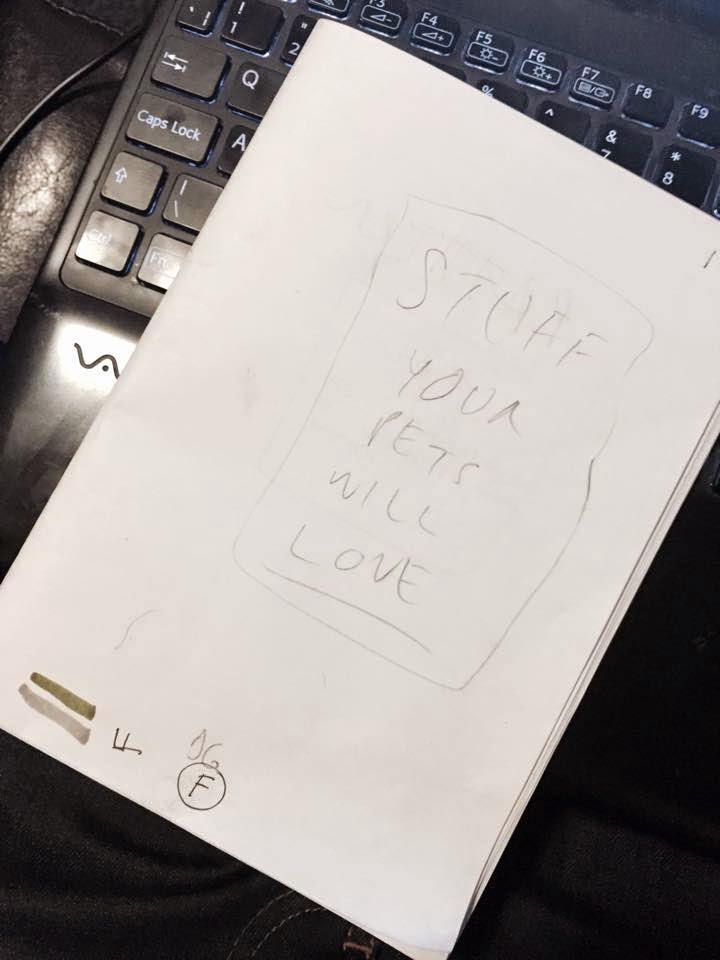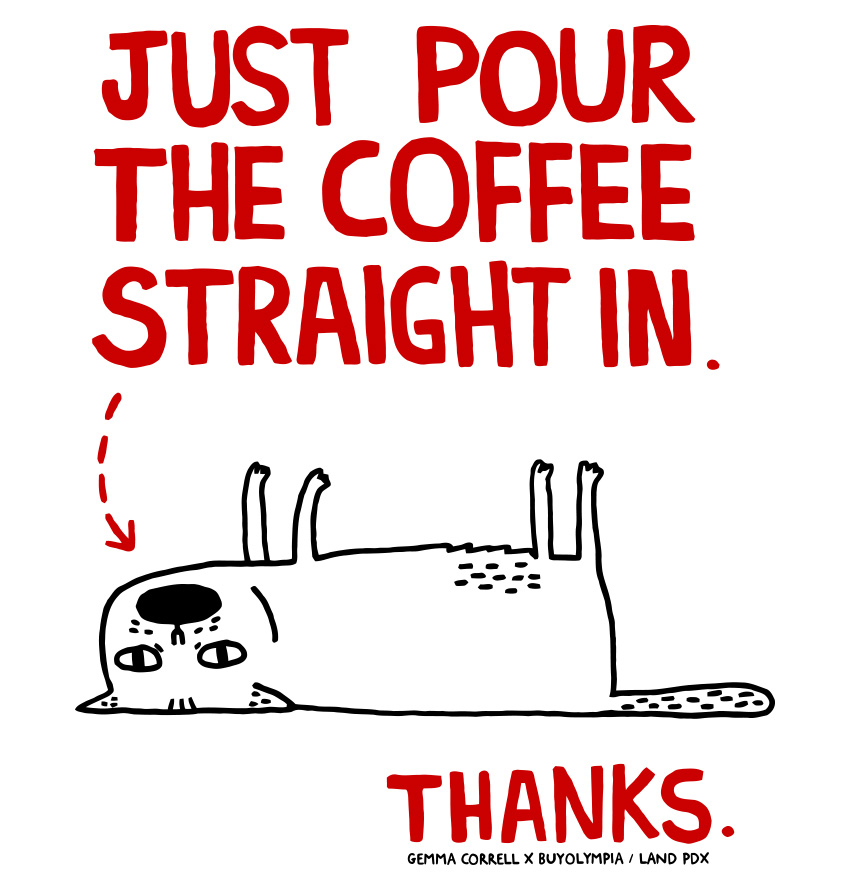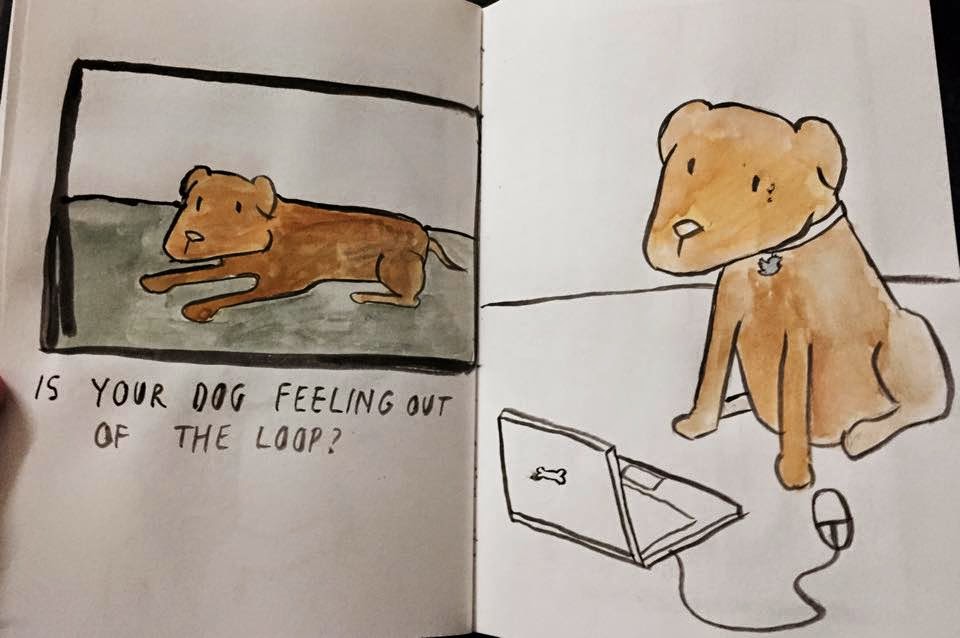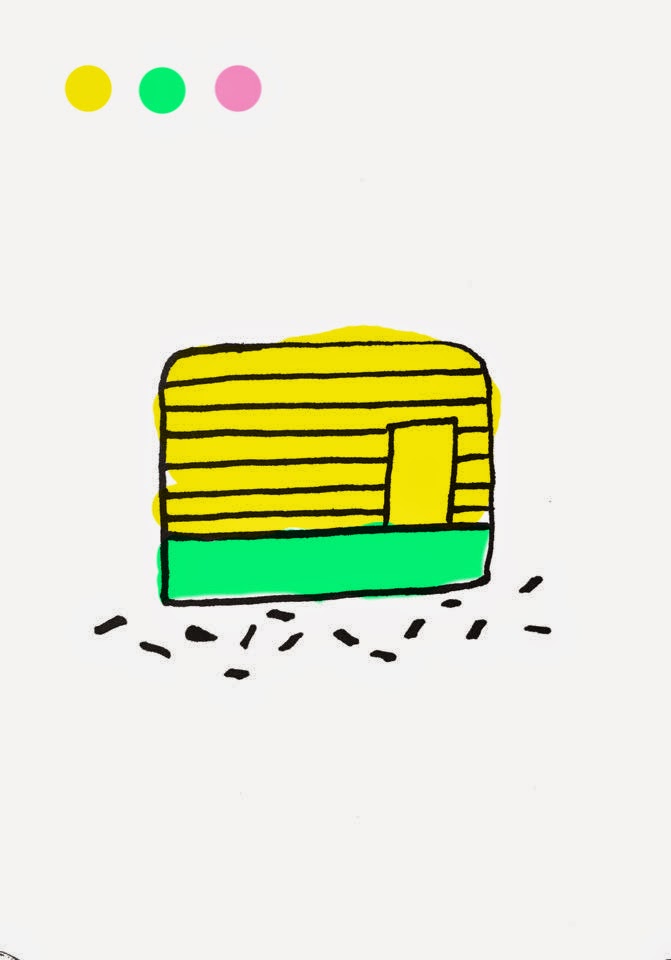Sunday 25 January 2015
End Of Module Self Evaluation 26/01/2015
The main practical skill I learnt during this module is how to use Indesign, which is a piece of software that was totally new to me. I found it really confusing at first, but am confident that I can use it for the basics. As it is an industry standard piece of software, I'm really grateful that I am able to use it at a basic level. Also prior to this module, I was unsure on the subject of DPI's etc and found that my images were always printed out in poor quality. I now know how to scan effectively, which will help my professional practice in the future.
This module has really made me appreciate the importance of research, and how it can benefit my work. I found that actually experiencing something first hand was really beneficial to me, helping me to form my own opinions and have my own experiences, for example, In the pet shop I was able to feel the atmosphere of the shop, and see what kind of people visit. In terms of interrogating my research, I have relied alot on group critiques to sway me towards a certain pathway.
I think that my main area for improvement would be my habit to neglect certain ideas, in terms of not capitalizing on effective elements in my work and not exploring them exhaustively. I feel that this is where I am mainly lacking and that my concepts are often unrefined. In the future I need to correct this by experimenting alot more, for example, using new and different medias. Another area from this module would be my lack of first hand research, I feel that more visits to pet shops would have helped me to refine and backup my concept.
I feel I am making decisions very confidently in terms of moving my project forward. I feel that I have been able to carry out the necessary research and reflect on what is needed to make my outcome successful. One of my main goals for studio brief 3 was to create a book that conveys humor, and so I tried to experiment with different styles of working, to see which one creates the right tone of voice. I think that the key to decision making is having enough evidence to back up your decision, which may be improved If I am able to explore ideas more exhaustively in the future.
Studio Brief 2: Tell An Untold Story - Mega Crit
Feedback Sheet from Mega Crit:
Recently I took part in a Critique, based on my courses final outcomes for the book project. Aswell as my class, it involved Animators and 2nd year illustrators, and was really nice to get to meet them. I was so overwhelmed by my classes standard of books, and it was great to see the amount of time and craft that had gone into each one.
Overall I was absolutely thrilled with my feedback, and got 100% positive comments. I'm so glad that my book achieved its goal in generating humor, as I was slightly worried that I was trying too hard. Another amazing comment was that 'If it was in a shop, i'd buy it'. The fact that my book looks professional and engages with the reader is amazing to me and I'm really proud of what I've achieved.
Studio Brief 2: Tell An Untold Story - Final Outcome
Stuff Your Pets Will Love (Probably)
This is my final printed outcome for this project, printed with an inside cover that I designed to give it more of a professional finish. Overall I am really pleased with the outcome. I am confident that the content inside the book is ordered effectively, and that each page is consistent in it's aesthetic, and that the style of illustration I have created is effective in conveying humor. When binding the book I found it really satisfying to see all my images together. Im also thrilled to have learnt how to sew books which is a new skill I know will come in handy in future.
One thing I am slightly unhappy about is the print quality on some pages, as there are accidental grey boxes around some of my images from where I have not edited properly. Although they are not easily noticed, I feel it is something that I need to focus on in the future when printing finalized work.
Studio Brief 2: Tell An Untold Story - Final Images & Mockup
Final Images for book (to be displayed as double page spreads):
To finalise my images and help them to communicate easier, I used language that is very simple to understand that has a spoken feel to it (although it is pretty much nonsense). I found it quite difficult to ensure that the text is consistent throughout, however I wanted my book to maintain a handwritten relaxed feel, to hopefully convey humor easier. I don't think it would have had the same effect with digital type. Overall I am really pleased with the design, layout, colour schemes and overall appearance of my book, I feel like it is the exact aesthetic I was hoping to create.
Final Book Mockup:
I decided to make a mockup of my book, so that I was able to order the pages. I personally felt that some pages were funnier than others, so I attempted to space the funnier ones out in order to pace the book and also ensure that the gags are timed right. It also helped when printing in indesign, as i was able to just take apart my mockup and see how the pages would be printed out.
Studio Brief 2: Tell An Untold Story - Final Image Digital Experimentation
Before choosing a colour scheme for my book, I experimented with the front cover. I wanted there to be a simplistic colour scheme throughout the book, and felt that the front cover would be the best place to start, to see what tone is set. When coloring my images in Photoshop, I knew that I didn't want to focus too much on using colour because I feel that the most successful humor illustrations do not use alot of colour, or use very muted colour palettes. Here I tried out some experiments using the colour blue, which I felt was quite a neutral colour, but still creates a sophisticed tone of voice. I like how it is quite an unusual colour scheme for animals also.
I think that my front cover design is really effective and conveys everything that I need it to. I think that the looser style of text and the simplicity of the colour schemes generates a light hearted relaxed feel for my book. However, i think that the use of the darker blue creates more of a sophisticated look, as opposed to the other 2 experiments.
Here are some experiments for the imagery inside my book. Because of the simplicity of my front cover, I like experiment 4 because of how it is just a small injection of colour to break up the page.
Studio Brief 2: Tell An Untold Story - Generating Final Images
From what I have researched into illustrators that use humor, I felt confident to start creating some images for my final book. I decided to change the style of my drawing from quirky and charming, to something a little more sophisticated, using neater fine lines.
I found that by doing something as simple as changing the eyes on my animals that a whole new effect has been created. I think that this particular style makes the animals look more human, and gives a sense of a personality.
Mockups:
I found that by doing something as simple as changing the eyes on my animals that a whole new effect has been created. I think that this particular style makes the animals look more human, and gives a sense of a personality.
Mockups:
I slightly struggled to make the animals look consistent in a particular style, however I think I managed. I attempted to use smoother lines to create caricature-esc imagery of the animals.
Final Images:
When creating these images, I took alot of inspiration from Gemma Correll and her use of grey ink/marker to add tone and variation to her drawings. I'm really happy with how they turned out and think that they create the right tone of voice for my concept, and hopefully humor.
Studio Brief 2: Tell An Untold Story - Artist Research/Inspiration
Now that I have established my chosen ideas for each page, I decided to have a look at other artists that convey humor, and products that are available. I really wanted to see how certain techniques are employed to generate humor.
Phil Jones - Creating a different kind of humor to what I want to achieve, however I think that his style is sophisticated in terms of its tone of voice. I think that the simplistic, bleak composition is quite on trend in the illustration industry, where humor is being created.
Gemma Correll - Gemma Correll is one of my favorite illustrators because of her really authentic, hand drawn style. I think she communicates humor really effectively, once again through her simplistic colour schemes and punchy style. Her use of language also contributes greatly to the humor aspect, which is something I intend to use in my own work.
Chris Simpsons Artist - Another one of my favorite illustrators who never fails to make me laugh. His style of humor is really unique but is still very popular. I think his choice of language fits perfectly with his wacky caricatures, which is what makes his work so brilliant. His tone of voice is created through his simple and grammatically incorrect use of language.
Studio Brief 2: Tell An Untold Story - Idea Generation & Refinement
Spider Diagram of new (hopefully) funnier ideas:
Here I have acted on the feedback from Matt and generated some ideas that I am confident with.
I also focused on the composition of my images, and attempted to create an image that will go in my final book.
Studio Brief 2: Tell An Untold Story - Chat with Matt
I had a talk with Matt about the work I had done so far and some composition experiments I had been working on. I wanted to create more of a scene, as opposed to just floating spots on a page. I feel that the composition works well in the dog image, because of the box in the background. However, in the fish image the composition is weak and unnecessary.
We also discussed my personal progress on the course, and how in some cases I am not focused/dedicated enough, which I felt was fair to say. I'm glad that this was discussed however as I am now clear on the amount of work I should be doing, which will help for future briefs.
It was also brought up that my ideas are not funny enough, and it is apparent that I do not have confidence in them, so my focus is to once again, go completely over the top and think of ideas that will make the reader laugh. And again I was advised to make a storyboard/mockup so I can see how my book will function.
We also discussed my personal progress on the course, and how in some cases I am not focused/dedicated enough, which I felt was fair to say. I'm glad that this was discussed however as I am now clear on the amount of work I should be doing, which will help for future briefs.
I really feel like this talk was a massive turning point for me, for this project and the rest of my future on this course.
Studio Brief 2: Tell An Untold Story - Tutorial
Tutorial Record Sheet:
Main Points:
- Think of 16+ ideas for book, that I genuinely believe are funny. Creating humor is quite tricky, all gags have to be perfectly timed etc. Try and make myself laugh with my ideas, go way over the top otherwise it won't be funny.
- Use of language in previous sketches is slightly over the top and unnecessary, shouldnt have to spell it out for the reader.
- The use of inky lines works well for creating humor, not sure about borders though.
Studio Brief 2: Tell An Untold Story - Critique
Critique Feedback Sheet:
I was really pleased with the feedback I got based on my previous work. One of the main things I was pleased about, was the fact that people found my concept interesting and relatable. Also the fact that the humor was conveyed is really great to hear.
Some things to work on:
- Create a real Mock Up to see how the book functions
- Experiment with more media, pencil crayons maybe?
Studio Brief 2: Tell An Untold Story - Visual Experimentation (cont)
After my last set of research, I decided to start creating some images based around problems pets may have and how to help them. Whilst doing this, one of my main goals was to create a particular tone of voice that conveyed humor, and so I experimented with fine liner and more loose style inky lines.
Initially I did a quick drawing using fine liner of an idea that popped into my head. I tried to think of as many 'ridiculous' pet inventions that I could, e.g Fish Psychologist. I wanted to convey the idea that some pet owners are so crazy that they will buy anything if they think it will help their pets, even if some of the products are completely illogical. I'm not sure on the style of this however, as I would like my images to have more of a naive, hand drawn quality to them.
I feel this set of images are alot more like what I aimed to create, although I feel that the content of the images aren't particularly 'crazy' or 'silly' enough, I feel that this style works really well in terms of creating humor, and the use of water colour and ink create the hand rendered effect I was hoping for. I think the colour schemes in the images work really well also.
Here I looked at the idea of how pet owners would react to hearing about a problem that their pets may have, continuing with the ink and watercolour style. I think this style is really effective, however I would like to try the images in different media, e.g gouache, to see if the boldness of the colours creates the same effect.
Studio Brief 2: Tell An Untold Story - Further Research
"The irrational world of owning a pet"
Stupid Things pet owners need to stop doing:
Stupid Things pet owners need to stop doing:
- Large expensive cages
- Christmas presents (Wrapped up and everything)
- Buying stuff that pets will "love" (useless shit that pet owners think their pet will love)
- Dressing pets in anything more than a collar
- Throwing them birthday parties (with birthday cakes)
"Things that are normally for human children are not for your dog" - "your pet is your child"
Crazy Pet Accessories (Collected from various sites online and conversations with pet owners)
- Twitter Account Collar
- Dog Snuggie
- Dog Thong
- Goldfish Walker
- Bum Covers
- Dog Washing (Traumatization Machine)
- Dog Sex Toy
- Sparkling Water (for pets)
- Frozen Yogurt
- Perfume
- Dog Ice Cream (why)
- Luxury Houses
- Treadmill
- Gold Threaded Pet Mattress (£3,000)
- Nail Pawlish
- Pet Tattoos (how cruel)
Creature Comforts
Whilst watching Creature Comforts, I decided to make some notes about issues discussed in the episodes, that I feel may aid my work. Issues that pets may have:
Whilst watching Creature Comforts, I decided to make some notes about issues discussed in the episodes, that I feel may aid my work. Issues that pets may have:
- Why do hamsters run in wheels? They think they're going to use it to escape, but find out they are trapped forever when they run into a wall.
- Hamsters like the sun because it feels like a big electric blanket.
- Tortoise needs his sleep
- Pets in pet shop feel rejection when they are the last ones to go - pessimistic ugly pets.
- Cats are very touchy feely and like to give massages
- Cats also like cigarettes.
These notes may not appear useful now but I feel that they will give me a starting point for drawing. It was really interesting to hear some thoughts that pets may have in regards to their owners, environments etc, but do it whilst conveying humor.
Studio Brief 2: Tell An Untold Story - Visual Experimentation
To start the visual exploration of my ideas, I created some sketches, initially inspired by one of my drawings from the research trip, based on the idea of large excessive hamster cages. The drawing was from a very large scale hamster cage that made me think it was a 'tad extravagant'. I had an idea that throughout the book, the cages would get bigger and more ridiculous.
After the crit with Kristyna I was given the idea to look at Pet personalities, and so I also experimented with character design. I feel that this idea however has been done before, and would not benefit my book.
I created these drawings using a Copic marker which I felt gave my images an authentic, cheeky vibe. I really liked the small line pattern that I used when drawing the saw dust as I feel that it gives the images effective intricate detail. I think that the style of these images are something that I want to take forward to my final book.
Some digital experiments with colour
As much as I love this idea, I feel it is quite basic and perhaps struggles to communicate my message of crazy pet owners. I am glad that I have tested this out though, as I really like the aesthetic of the images, which I can take forward to my final book design. I intend to do some more research into pet products, and perhaps try out the evolving cage idea with other pets.
After the crit with Kristyna I was given the idea to look at Pet personalities, and so I also experimented with character design. I feel that this idea however has been done before, and would not benefit my book.
Subscribe to:
Posts (Atom)





















































